Today we visited the “Foire da Paris.” This is a HUGE exposition, kind of a combination of the Coconut Grove Art Festival, the Home Show, Walmart, and the South Beach Food and Wine Festival all in one big, big, place. Here’s the website, if you want to take a look. We headed directly for the “vins & gastronome de France et d’Europe” – the food and wine pavilion. Oh-my-God. The pavilion was about the size of the Miami Beach Convention Center. It was filled with booths featuring everything you can imagine – sausages, cheese, hams, wine, foie gras, pastries, candy, nuts, confections, wine caves, olives, plus a couple dozen restaurants scattered about – some looked like they would easily seat 50-100 people. It was pretty overwhelming when we walked in the door, especially the fact that there was a LOT of cooking going on, and the air was filled with some pretty luscious aromas. We decided to be organized, so we headed for one end of the hall, and started to hike back and forth through the fair.
I won’t go through the whole things (mostly because I can’t remember it all), but the high points… We tried foie gras from several vendors, most direct producers. The second place we tried turned out to be the best, and we ended up going back there to buy some to bring home (if it lasts that long). It was from Perigord, which is one of the main places for foie gras. This was duck foie gras (foie grad du canard) and it was soooo delicious. Most of the booths had samples of their wares, and we certainly indulged!
There was a large Grand Mariner booth nearby; we tried a Grand Marnier Alexander – blue label, served cold, definitely on our BUY THIS list – we forgot to go back and get a bottle, but it will certainly be on our list when we return to Paris. It wasn’t as sweet as the regular Grand Mariner, perhaps because the cold suppresses the alcohol, but it was very, very good. I think Tio Paulo had a second glass when no one was looking.
Right across from the Grand Mariner stand featured hams, sausages, and cheeses. Here’s a picture.
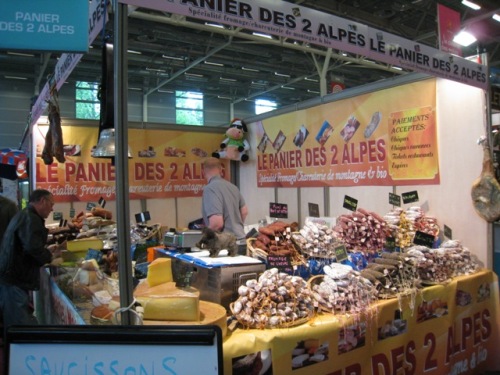 The sausages (which I sadly couldn’t try) were delicious, according to Myriam and Tio Paulo. When I looked at the signs for them, they were labeled “Fromage du Chevre”, “Cepes (mushrooms)”, “Beaufort”, and so on. When I first walked over, I thought that they were cheeses and so on, but it turned out that when they made the sausages, the blended whatever was on the label – so the Fromage de Chevre sausage had bits of goat cheese worked into the body, and so on. We bought three – one of each. They had a ton of options – poivre, other cheeses, and so on. They smelled great. But I was not left out, no sir! They had some Beaufort cheese, a Fromage de Chevre, and a nice Brebis, all of which I tasted. What a difference from Miami! Shipping across the Atlantic sure impacts the flavors.
The sausages (which I sadly couldn’t try) were delicious, according to Myriam and Tio Paulo. When I looked at the signs for them, they were labeled “Fromage du Chevre”, “Cepes (mushrooms)”, “Beaufort”, and so on. When I first walked over, I thought that they were cheeses and so on, but it turned out that when they made the sausages, the blended whatever was on the label – so the Fromage de Chevre sausage had bits of goat cheese worked into the body, and so on. We bought three – one of each. They had a ton of options – poivre, other cheeses, and so on. They smelled great. But I was not left out, no sir! They had some Beaufort cheese, a Fromage de Chevre, and a nice Brebis, all of which I tasted. What a difference from Miami! Shipping across the Atlantic sure impacts the flavors.
We hit a booth with products from Cahors; we tried a couple of the wines (malbecs). Different than the Argentine version. Tio Paulo doesn’t like the Argentine version; the Cahors Malbecs are more minerally and tannic; not as fruit-forward as the Argentine versions. Austere would be a good description. Quite good though. The fellow at the booth was quite generous with his pours (not good so early in the show, but we didn’t complain). On our second wine, he produced some foie gras from that region, which was just smashing with the wine.
A booth from Pays de Basque featured olives – lots and lots of olives (also not on my favorites list), but Myriam and Paulo happily tasted their way through several varieties, proclaiming them outstanding.
What was interesting about this fair is that you could buy anything from the vendors; not like most in Miami where you cannot. We were going to wait until we left to revisit the booths that we really liked, but that fell by the wayside.
Let’s see… we found a booth that featured tapenades and aperitifs from Corse. One that caught our attention was a cherry liquor with hot pepper blended in. Sounds strange, but it was delicious. Kind of sweet on the first sip, but as it coated your mouth, a slow burn set in from the pepper. Wonderful contrast in flavors. Speaking of Corse, we also found a booth that featured pork and cheese products – quite good – where I had my very first taste of “Brin du Maquis” – not sure if it was Brin d’Amour or Fleur d’ Maquis; both are similar cheeses, but nothing like the cakey version you find in Miami. I think that the way they store the cheeses in Miami doesn’t allow enough moisture to escape; this was more of a semi-hard cheese with a lighter coating of rosemary. I suspect that by the time it gets to Miami, the moisture in the cheese probably affects the rosemary, making that taste stronger, and the cheese more soft.
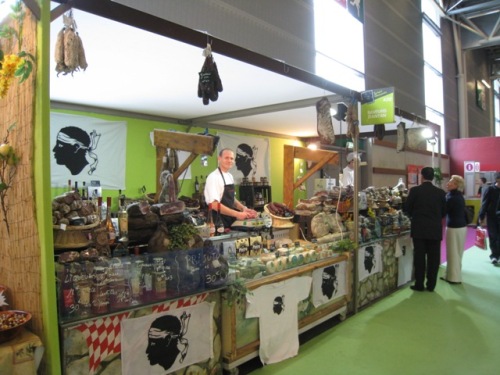
Of course, we hit quite a few wine and champagne booths, trying a number of very nice wines. Nuits St Georges was one of the better offerings. There were several booths with Jurancon but I never had a chance to taste (bummer).
About half way through the show, we came upon a booth featuring cheeses from Salers; they had a fermier St. Nectaire, that was so creamy and delicious I almost bought a chunk. They also had Morbier and several Cantals, including one that was 20 months old. The rind was craggy and fissured. As it ages, the rind is invaded by cheese mites (like Mimolette), which give it this appearance. According to my cheese reference, Cantal purists (of which I am now one) believe this is when the cheese is best. Our cheese monger friend was dispensing samples of the paste, which was just fabulous. Meaty and sweet, with a very nice, lingering aftertaste. It has a faint floral taste that was quite pleasant.
There were two women standing next to us that we was explaining the rind to. Next thing I knew, he cut off a piece and held it out, asking (in French) who was courageous. I stuck my hand out and took it. Frankly, the cheese from the outside looks quite…not disgusting, but definitely within my “would you put that in your mouth” guidelines (which have now become quite relaxed). But ever dedicated to my craft, I popped it in my mouth and chewed it up. Very interesting. The taste was a pleasant loamy, kind of dusty taste, with an incredibly intense flavor of the cheese that was closest to the rind. In any cheese, that part near the cream line is the most aged portion. As the cheese mites burrow into the rind, they expose that first layer to the air and microbes. The Cantal actually forms kind of a bloom at this point, which also contributes to a (this will sound strange if you’re not a cheese lover) pleasant moldy taste.
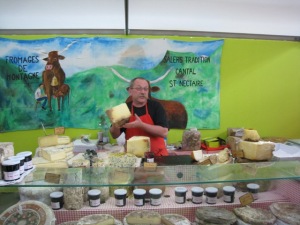
Well, for my courage, he rewarded me with a nice glass of Pomerol, which absolutely made the whole experience worthwhile, and gave me quite a nice boost of flavor from the cheese! Vive la Cantal!
We found a Champagne booth that had an American inside- she was from New Mexico, and told us that New Mexico was where the American Wine industry came into being, before prohibition. She gave us the name of a sparkling wine producer there who makes (according to her) a great sparkling wine. We shall see. We bought a bottle of their Rose for Hugette; we’ll try that when we go back.
Lunch was a sandwich of Brebis cheese on a baguette. Yum. We soldiered on, trying more foie gras; the best we found was extremely expensive 5 small cans were almost 80 euros, so we decided we weren’t quite that refined and moved on.
We headed back to the 11th, happy and tired, where we had a very light salad for dinner, and went off to bed. Early morning Thursday to catch the 8am train to Toulouse!
25.721333
-80.268602
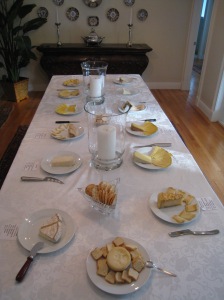
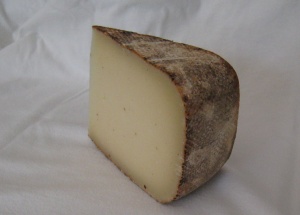
 This is the piece of Beaufort I brought back from France. As you can see, it has a more yellow-than-whitish color to the paste. The shop labeled it Beaufort d’été, meaning that it was produced in the summer. The summer production period ranges from June through October, and occurs in a dairy, rather than in the mountains. The cheese shop did not have the aging time of the cheese, but if it was from September or October, it would probably have been 6-9 months. I suspect it’s at the older end because the taste is so deep and rich.
This is the piece of Beaufort I brought back from France. As you can see, it has a more yellow-than-whitish color to the paste. The shop labeled it Beaufort d’été, meaning that it was produced in the summer. The summer production period ranges from June through October, and occurs in a dairy, rather than in the mountains. The cheese shop did not have the aging time of the cheese, but if it was from September or October, it would probably have been 6-9 months. I suspect it’s at the older end because the taste is so deep and rich.
 The sausages (which I sadly couldn’t try) were delicious, according to Myriam and Tio Paulo. When I looked at the signs for them, they were labeled “Fromage du Chevre”, “Cepes (mushrooms)”, “Beaufort”, and so on. When I first walked over, I thought that they were cheeses and so on, but it turned out that when they made the sausages, the blended whatever was on the label – so the Fromage de Chevre sausage had bits of goat cheese worked into the body, and so on. We bought three – one of each. They had a ton of options – poivre, other cheeses, and so on. They smelled great. But I was not left out, no sir! They had some Beaufort cheese, a Fromage de Chevre, and a nice Brebis, all of which I tasted. What a difference from Miami! Shipping across the Atlantic sure impacts the flavors.
The sausages (which I sadly couldn’t try) were delicious, according to Myriam and Tio Paulo. When I looked at the signs for them, they were labeled “Fromage du Chevre”, “Cepes (mushrooms)”, “Beaufort”, and so on. When I first walked over, I thought that they were cheeses and so on, but it turned out that when they made the sausages, the blended whatever was on the label – so the Fromage de Chevre sausage had bits of goat cheese worked into the body, and so on. We bought three – one of each. They had a ton of options – poivre, other cheeses, and so on. They smelled great. But I was not left out, no sir! They had some Beaufort cheese, a Fromage de Chevre, and a nice Brebis, all of which I tasted. What a difference from Miami! Shipping across the Atlantic sure impacts the flavors.
